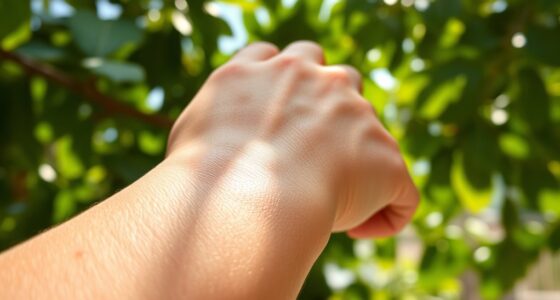To even out a patchy tan, start with gentle exfoliation to remove dead skin and create a smooth canvas. Moisturize well beforehand to help with even application. Use natural remedies like lemon juice, aloe vera, and vitamin C to fade uneven areas, and consider blending with a brush or mitt to prevent streaks. For stubborn patches, professional help can offer precise touch-ups. Keep in mind these tips to improve your tan—more details await to help you perfect your glow.
Key Takeaways
- Exfoliate the uneven areas gently with a scrub or mitt to remove dead skin and promote a more even surface before reapplication.
- Use natural remedies like aloe vera, lemon, or honey to lighten darker patches and improve skin uniformity over time.
- Moisturize thoroughly before and after tanning to enhance product adherence and prevent streaks or patchiness.
- Blend tanning products carefully around joints and dry areas, using a brush or sponge to minimize visible lines or uneven color.
- Consult a skincare professional for severe patchiness or persistent unevenness to receive targeted treatments or corrective procedures.
Understanding the Causes of Patchy Tans
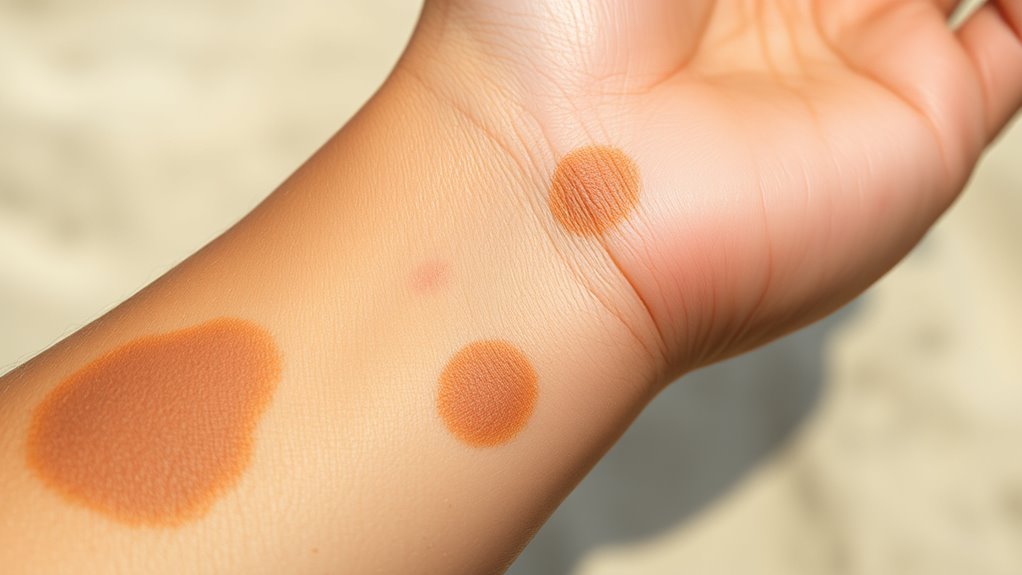
Patchy tans often happen because your skin doesn’t tan evenly, and various factors influence this inconsistency. One common cause is uneven melanin distribution, which causes some skin areas to darken faster or more intensely. Hormonal fluctuations from pregnancy or menopause can also alter pigmentation, making tans appear irregular. Age-related changes can reduce uniformity, leading to patchiness, while genetic factors predispose some people to uneven pigmentation naturally. Pre-existing skin conditions or irregularities can worsen uneven tanning after sun exposure. Additionally, improper sunscreen application creates protected and unprotected zones, causing uneven pigmentation. Hard-to-reach spots or facial contours are often missed during application. External factors like heat, injuries, or environmental toxins can disrupt normal pigmentation, further contributing to patchy tans. Proper sunscreen application techniques and consistent skincare routines are essential for achieving a more uniform tan. Incorporating exfoliation methods can help remove dead skin cells and promote more even skin renewal. Using appropriate sun protection tailored to your skin type and sensitivity can also help prevent uneven tanning and support a more consistent skin tone.
Natural Remedies to Reduce Discoloration

To effectively reduce skin discoloration caused by uneven tanning, natural remedies offer a safe and gentle approach. Aloe vera soothes skin and lightens sunspots and hyperpigmentation, easing the appearance of uneven tone. Vitamin C acts as an antioxidant, protecting your skin from UV damage and helping lighten dark spots through collagen promotion. Applying black tea water regularly can diminish hyperpigmentation over time. Licorice extract contains compounds that lighten discoloration caused by sun exposure and melasma. Lemon juice, rich in citric acid, helps brighten skin and fade tan, but use it cautiously to avoid irritation. Incorporating these ingredients into your routine can gradually even out your skin tone without harsh chemicals, making your tan look more uniform and natural. Additionally, understanding your skin type and local skincare tips can optimize your results and prevent further discoloration.
Effective Exfoliation Techniques for Tan Correction

Exfoliation is an essential step in correcting uneven tanning, as it helps remove dead skin cells that can cause streaks and patchiness. To prepare your skin, exfoliate 24 hours before applying self-tanner, allowing pores to close and ensuring an even base. Avoid exfoliating immediately before tanning, as damp or sensitive skin can hinder tan adherence. Use physical exfoliants like gentle scrubs or exfoliating mitts, which effectively lift dead skin without damage. Target areas prone to dryness—feet, elbows, knees—for thorough exfoliation to prevent patchiness. Focus on uneven patches or streaky areas with gentle circular motions, avoiding over-exfoliation. Regular exfoliation in the days leading up to tanning improves skin texture and helps achieve a smooth, uniform finish. Incorporating proper automation in skincare routines can also optimize preparation and application processes for better results. Additionally, maintaining consistent exfoliation helps sustain a smooth complexion, making the tan look more natural and even over time. Proper vacuum cleaner performance metrics, such as suction power and filtration, can ensure your skin remains free of dust and debris, supporting healthier skin. Incorporating knowledge about exfoliation frequency can further enhance your tanning results by preventing build-up and irritation.
Hydrating and Moisturizing for a Smoother Finish

Hydrating and moisturizing your skin is essential for achieving a smooth, even self-tan. Dry skin absorbs self-tanner unevenly, resulting in patchiness. Applying moisturizer well before tanning ensures the product applies smoothly and adheres evenly. It’s best to moisturize at least an hour prior to tanning to avoid interference with absorption. After tanning, regular moisturizing helps maintain the tan’s evenness and prolongs its lifespan. Drinking plenty of water boosts overall skin hydration, enhancing the tan’s appearance and longevity. Choose hydrating, non-comedogenic moisturizers with ingredients like hyaluronic acid or natural oils such as coconut oil. Proper hydration improves skin texture, reduces dryness, and creates a healthier glow, making your self-tan look more natural and uniform.
Buffing and Blotting to Blend Tan Variations
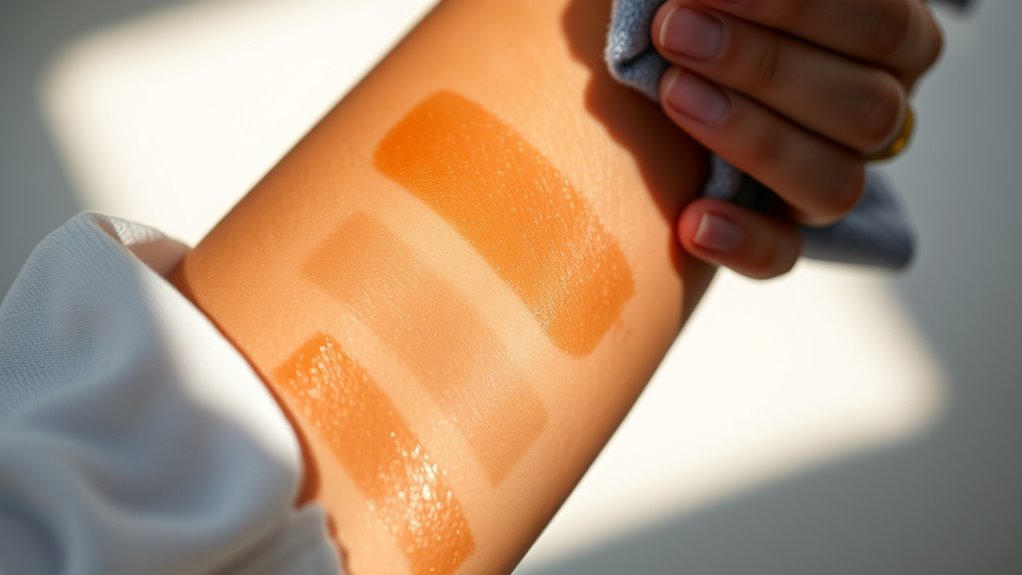
Buffing and blotting are essential steps for achieving a flawless, even tan. Buffing involves gently rubbing a brush or tool to blend tanning products into your skin, smoothing out streaks and uneven patches. Use light pressure to avoid dark spots or patchiness, especially around joints and dry areas. A soft, synthetic brush works best for delicate spots like the face and neck. Blotting helps absorb excess product or moisture, preventing build-up and dark spots. Use a tissue or cloth to gently pat areas prone to excess, such as ankles, wrists, or elbows. Continuous blending ensures all tan variations are minimized, and visible lines fade seamlessly. Proper buffing and blotting create a natural, uniform glow that looks flawless and polished. Additionally, considering the environmental considerations of your products, such as avoiding harsh chemicals, can help maintain healthy skin and a sustainable routine. Using advanced skincare technology, like AI-powered skin analysis, can also provide personalized recommendations for products that suit your skin type and environmental concerns.
Preventative Steps for a More Even Complexion
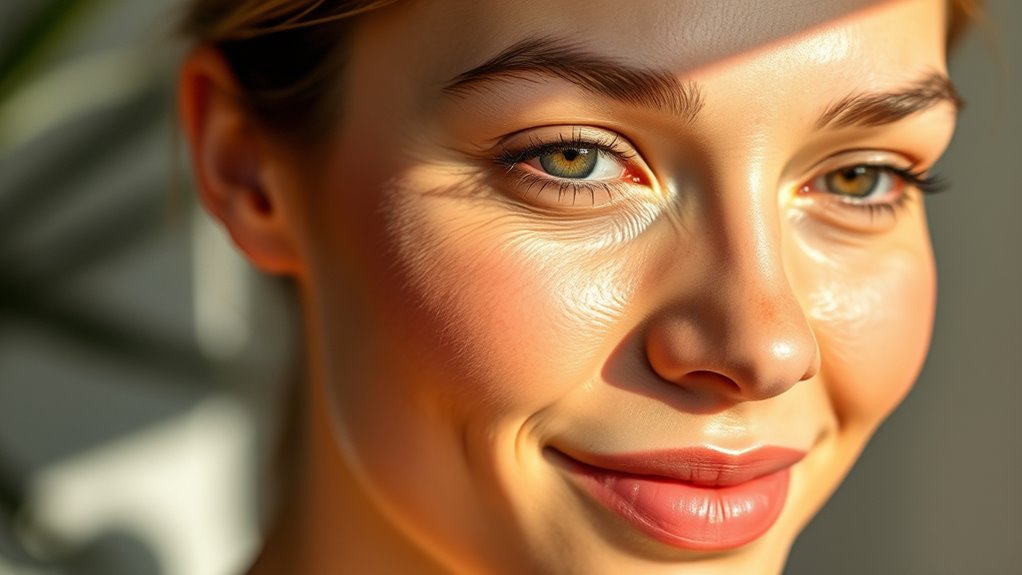
Maintaining an even skin tone starts with proactive daily habits that protect your skin from factors that cause uneven pigmentation. Apply broad-spectrum sunscreen with at least SPF 30 every day, reapplying every two hours when outdoors. Remember, UV rays can cause dark patches even on cloudy days or indoors. Keep your skin hydrated with noncomedogenic moisturizers immediately after cleansing to strengthen your skin barrier and prevent dryness and irritation. Avoid picking or squeezing blemishes, as trauma can lead to dark spots and uneven patches. Adjust your diet by reducing alcohol, spicy foods, and sugar, which can inflame skin. Use gentle cleansers and targeted serums like vitamin C or niacinamide to support a uniform complexion. Incorporating HEPA filtration and other air quality strategies can also help create a healthier environment that promotes skin clarity. These habits help prevent pigmentation issues and promote healthier, more even skin.
Tips for Applying Self-Tanner Uniformly
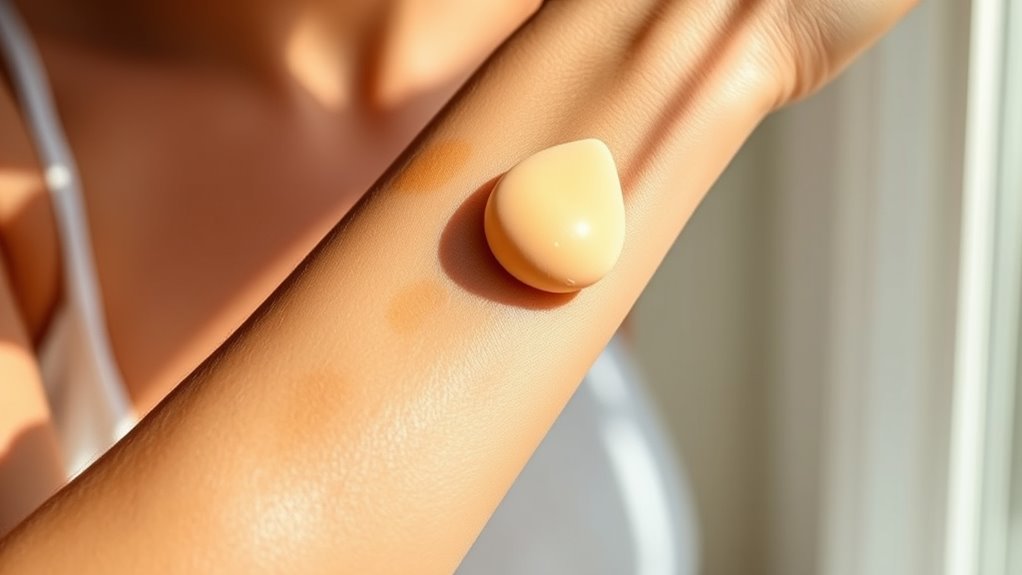
To achieve a streak-free, even tan, proper application technique is essential. Begin by exfoliating with a body scrub 24 hours before applying self-tanner to remove dead skin cells. Shave at least four hours prior to prevent irritation and uneven absorption. Pat your skin completely dry after showering, and avoid deodorants, perfumes, or moisturizers beforehand to prevent streaks. Use a tanning mitt for smooth, circular motions, applying product in sections—start at the ankles and work upward. Be mindful of creases on knees, elbows, and ankles; apply sparingly and blend thoroughly. Use the residual product on the mitt for hands, feet, and joints. Applying glycolic acid exfoliates dead skin cells, which can help achieve a more even skin tone for a natural-looking tan. Incorporating skincare routines can further improve overall skin health and enhance your tanning results. Additionally, choosing appropriate tanning products formulated for even application can make a significant difference. Ensure your bicycle tire pressure is correct before application to avoid uneven wear during outdoor activities. Apply two thin layers for a natural, even color, and allow the tan to dry fully before dressing.
Natural Products to Lighten and Fade Uneven Areas
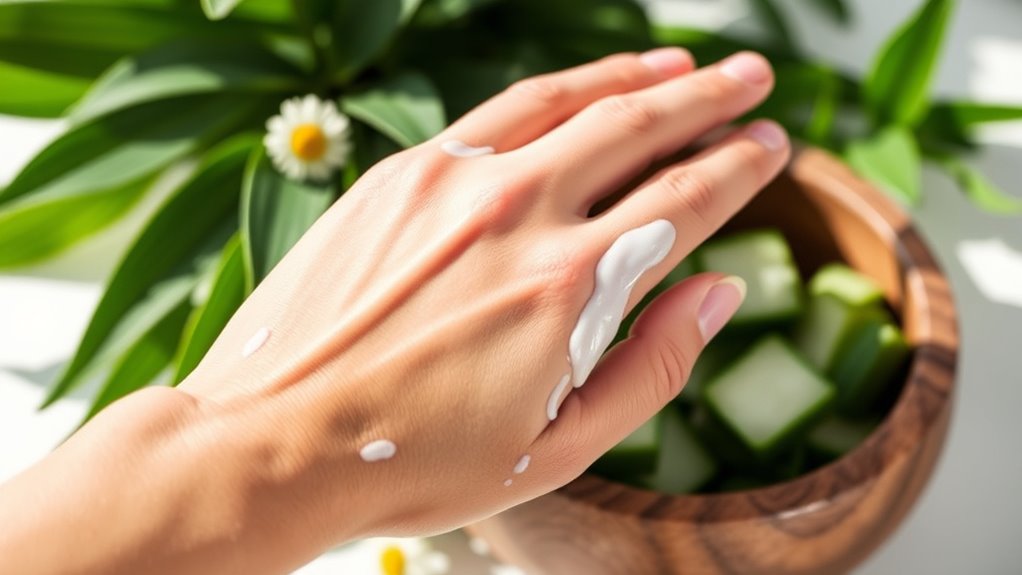
Natural remedies can effectively lighten and fade uneven tan areas without harsh chemicals. Lemon juice is a natural bleaching agent that breaks down excess melanin, helping to brighten darker patches. Mixing it with honey keeps your skin moisturized and prevents dryness after application. Apply this mixture for 20-30 minutes, then rinse thoroughly. Aloe vera gel contains antioxidants and enzymes that reduce pigmentation and soothe sun-damaged skin, promoting a more even tone over time. Its anti-inflammatory properties also help with healing. Coconut oil and other natural oils like olive or almond nourish and hydrate your skin, making tan lines less noticeable with consistent overnight use. Proper skin care routines can enhance the results of natural remedies and support overall skin health. Incorporating skin healing essential oils for skin healing like lavender or tea tree oil in your skincare regimen can further enhance the effectiveness of natural remedies. Baking soda acts as a gentle exfoliant, removing dead skin cells and boosting skin renewal. These natural products, used regularly, can markedly improve uneven tan areas. Understanding proper toilet maintenance and repairs can help you avoid skin issues caused by plumbing problems that might affect your skincare routine.
When to Seek Professional Assistance

Ever wonder if your uneven tan requires professional help? If you notice severe discoloration or prominent streaks and blotches, it’s time to see a pro. These issues often can’t be fixed with home remedies alone and may need expert correction. For upcoming events like weddings or special occasions, professional services can ensure flawless results. Regular visits help maintain consistency, especially if you’re prone to uneven tanning. Professionals offer personalized advice, precise touch-ups, and guidance on the best techniques and products for your skin. Preparing properly—like exfoliating and communicating your concerns—maximizes results. After a session, follow aftercare instructions and schedule follow-up appointments to keep your tan even and vibrant. When issues persist or worsen, seeking professional assistance is your best move for a flawless, uniform tan, especially if you’re dealing with personal debt forgiveness bills that could impact your financial planning for tanning or skincare treatments.
Frequently Asked Questions
Can Makeup Help Conceal Patchy Tan Areas Temporarily?
Yes, makeup can definitely help conceal patchy tan areas temporarily. You should start by choosing a foundation that matches your main skin tone and apply a primer to smooth your skin. Use concealer on the light patches, then blend everything seamlessly with a sponge or brush. Adding light layers of bronzer or setting powder over patchy spots can help create a more even appearance, making your skin look uniform throughout the day.
How Long Does It Typically Take to See Improvements With Natural Remedies?
Ever wonder how quickly natural remedies can even out your skin tone? Usually, you’ll notice short-term improvements within a few days, especially with exfoliation and lemon juice treatments. Aloe vera and coconut oil might take about a week to show significant changes, while consistent use over two to three weeks can fully balance your tan. Patience is key—stick with it, and you’ll see smoother, more even skin gradually.
Are There Specific Ingredients to Avoid When Correcting Uneven Tan?
When correcting an uneven tan, you should avoid harsh exfoliants and alkaline soaps, as they can irritate your skin and worsen the unevenness. Stay away from sulfates and mineral oils, which can strip natural oils and clog pores, making your skin issues worse. Fragrances might also cause irritation. Instead, focus on gentle skincare ingredients like aloe vera, vitamin C, and hydrating products to promote even skin tone.
Is It Safe to Exfoliate More Than Once a Week for Tan Correction?
Exfoliating more than once a week can be risky, especially for tan correction. You might strip too much of your skin’s natural oils, causing redness, irritation, and dryness. If you have sensitive or dry skin, sticking to once weekly is best. For oily skin, up to three times a week may be okay, but always watch for signs of over-exfoliation. Prioritize gentle products and moisturize well afterward to protect your skin.
Can Clothing or Accessories Affect the Appearance of Uneven Tan?
Clothing and accessories are like silent artists creating shadowed patterns on your skin, influencing your tan’s appearance. When you wear straps, jewelry, or tight fabrics, they block UV rays, leaving marks and uneven patches. To avoid this, remove accessories before tanning, choose minimal clothing, and reposition straps during exposure. These steps help guarantee a more uniform tan and prevent those unwanted tan lines from becoming permanent art on your skin.
Conclusion
With patience and proper practices, you can perfectly patch up your patchy tan. By blending, buffing, and buoying your skin with natural remedies and consistent care, you’ll achieve an even, radiant result. Remember, prevention is key—so stay proactive and persistent. With these simple steps, say goodbye to blotchy, broken tans and hello to a beautifully balanced, bronzed glow that beams with confidence!



